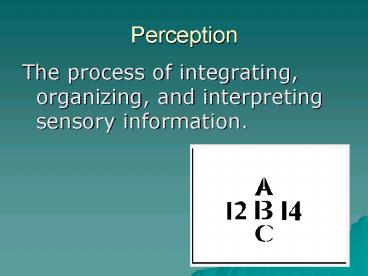Perception - PowerPoint PPT Presentation
1 / 34
Title:
Perception
Description:
Gestalt theorists argued that our perceptual systems automatically organized ... Good Continuation. Common Movement. Good Form. Depth Perception ... – PowerPoint PPT presentation
Number of Views:80
Avg rating:3.0/5.0
Title: Perception
1
Perception
- The process of integrating, organizing, and
interpreting sensory information.
2
(No Transcript)
3
(No Transcript)
4
(No Transcript)
5
Gestalt Grouping Principles
- Gestalt theorists argued that our perceptual
systems automatically organized sensory input
based on certain rules - Proximity
- Similarity
- Closure
- Good Continuation
- Common Movement
- Good Form
6
(No Transcript)
7
(No Transcript)
8
(No Transcript)
9
(No Transcript)
10
(No Transcript)
11
Depth Perception
- One of our more important perceptual abilities
involves seeing in three-dimensions - Depth perception is difficult because we only
have access to two-dimensional images - How do we see a 3-D world using only the 2-D
retinal images?
12
Depth Perception Cues
- Cuestimulus characteristics that influence our
perceptions - We are able to see in 3-D because the visual
system can utilize depth cues that appear in the
retinal images
13
Types of Depth Cues
- Depth cues are usually divided into categories,
we will consider two types of depth cues - Monoculardepth cues that appear in the image in
either the left or right eye - Binoculardepth cues that involve comparing the
left and right eye images
14
Monocular Depth Cues
- Relative image size
- Linear perspective
- Texture gradient
- Overlap
- Aerial perspective
- Motion parallax
15
(No Transcript)
16
(No Transcript)
17
(No Transcript)
18
(No Transcript)
19
(No Transcript)
20
(No Transcript)
21
- Motion Parallax
22
(No Transcript)
23
(No Transcript)
24
Binocular Depth Cues
- Our best depth perception occurs if we look
through both eyes - This is because our right and left eyes see a
slightly different view of the world this is
called binocular disparity - Convergence is the degree to which your eye
muscles must rotate to see an object.
25
(No Transcript)
26
(No Transcript)
27
Stereogram
- Another way to create the illusion of depth
through binocular with a stereogram - A stereogram is formed by superimposing two
repeating patterns - The two patterns are slightly offset when viewed
properly, this offset is seen as a binocular
disparity
28
Stereogram
29
Perception of Motion
- Process that is not very well understood
- Usually assume that the figure is moving and the
ground is stationary - Stroboscopic motion--perception of motion caused
by carefully timed flashing lights
30
PhiPhenomenon
- Apparent motion
31
Perceptual Constancy
- When viewing conditions change, the retinal image
changes even if the objects being viewed remain
constant - Example as a person walks away from you, their
retinal image decreases in size - Important function of the perceptual system is to
represent constancy in our environment even when
the retinal image varies
32
Size Constancy
- Cylinders at positions A and B are the same size
even though their image sizes differ - The depth cues such as linear perspective and
texture help the visual system judge the size
accurately
33
Shape Constancy
- It is hard to tell if the figure on the upper
right is a trapezoid or a square slanted backward - If we add texture, the texture gradient helps us
see that it is actually a square
34
Perceptual Completion































